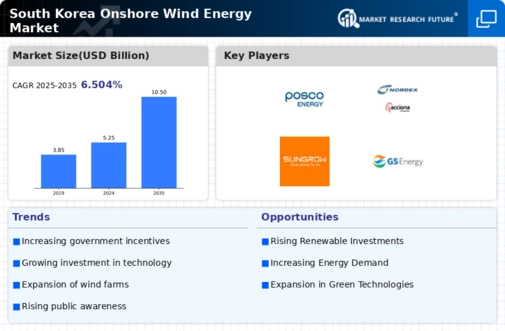The South Korea Onshore Wind Energy Market has seen significant growth in recent years, fueled by increasing environmental awareness and governmental support for renewable energy sources. As the nation endeavors to transition towards cleaner energy methods, a sense of competition has emerged among key players in the market. The competitive landscape comprises various companies that are focusing on innovation, operational efficiency, and strong project execution to capture market share. The industry's performance is bolstered by advancements in wind turbine technology, the strategic acquisition of land, and collaboration with research institutions to enhance efficiency.
Additionally, the commitment of the South Korean government to promote extensive renewable projects enhances the competitiveness of the onshore wind energy sector, facilitating entry for new players while pushing existing companies to innovate and expand their portfolios.POSCO Energy stands out in the South Korea Onshore Wind Energy Market with its strong reputation and robust operational capabilities. Established as a front-runner in the clean energy sector, POSCO Energy has capitalized on its extensive experience in industrial energy production and engineering excellence, providing the company with a competitive edge.
The company has developed a portfolio of onshore wind projects that leverages their technological prowess to deliver reliable energy solutions.
Their financial strength and commitment to sustainability enable POSCO Energy to undertake large-scale projects while maintaining efficiency. This position allows them to forge partnerships and alliances that further enhance their capacity to undertake renewable energy initiatives. As a dominant player, POSCO Energy is well-positioned to navigate challenges in the industry and capitalize on emerging opportunities, thereby reinforcing its market presence in South Korea.Hanwha Energy has made a notable impact on the South Korea Onshore Wind Energy Market through its extensive range of services and commitment to sustainable energy.
The company offers various innovative energy solutions, including the development and management of wind energy projects tailored to meet the growing energy demands of the region. With a robust portfolio of wind farms, Hanwha Energy leverages its technical expertise and financial backing to enhance power generation efficiency and operational reliability. Additionally, the firm has made strategic investments and partnerships that have allowed for expansion in renewable energy capacity, significantly strengthening its market position.
Hanwha Energy also emphasizes the importance of sustainability in its operations and is dedicated to adapting to new regulatory environments to remain compliant while pursuing mergers and acquisitions that align with its goals in the South Korean energy landscape.
This proactive approach not only consolidates their strength in the wind energy sector but also reinforces their commitment to contributing to South Korea's energy transition goals.















Leave a Comment